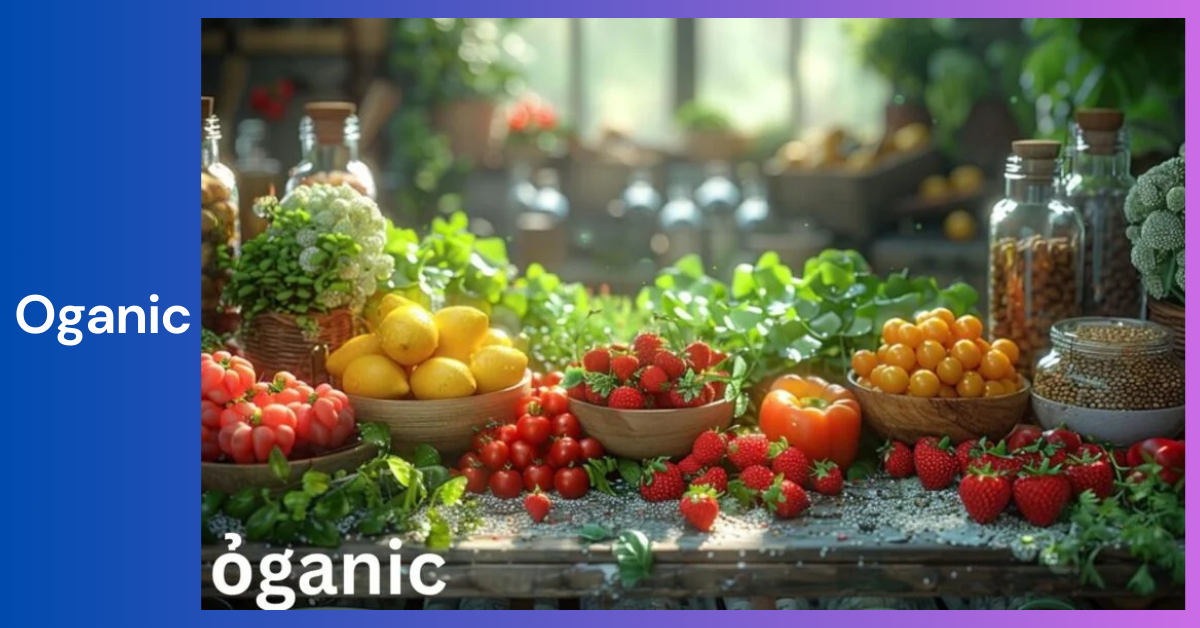
In the quest for healthier lifestyles and sustainable living, “ỏganic” foods have become a focal point for many consumers.
This article provides an in-depth exploration of what “ỏganic” means, its numerous benefits, and its impact on health and the environment.
With a focus on clarity and readability, this guide will help you understand why making the switch to ỏganic could be one of the best decisions for your well-being and the planet.
What Does “ỏganic” Mean?
Defining “ỏganic”
The term “ỏganic” refers to agricultural products that are produced and processed without the use of synthetic chemicals, genetically modified organisms (GMOs), or artificial additives.
Organic farming practices emphasize natural methods to grow and process food, aiming to maintain soil health, promote biodiversity, and reduce environmental impact.
Core Principles of Organic Farming
- Natural Fertilizers: Organic farms use natural fertilizers such as compost and manure to enrich the soil, avoiding synthetic chemical fertilizers.
- Pest Management: Instead of synthetic pesticides, organic farming employs biological pest control methods, including beneficial insects and crop rotation.
- Soil Health: Organic practices focus on maintaining soil health through techniques like cover cropping and reduced tillage.
The Health Benefits of “ỏganic” Foods
1. Enhanced Nutritional Value
Many consumers believe that ỏganic foods offer superior nutritional benefits compared to conventionally grown produce. Research indicates that ỏganic fruits and vegetables often contain higher levels of certain nutrients, including:
- Antioxidants: Organic produce may have higher antioxidant levels, which can help neutralize free radicals in the body and reduce oxidative stress.
- Vitamins and Minerals: Some studies suggest that ỏganic foods have higher concentrations of vitamins such as Vitamin C and minerals like magnesium.
2. Reduced Chemical Exposure
One of the primary reasons people choose ỏganic foods is to minimize exposure to harmful chemicals. Conventional farming often uses synthetic pesticides and herbicides, which can leave residues on produce.
By opting for ỏganic, you avoid these chemicals, reducing potential health risks associated with long-term exposure.
3. Lower Risk of Antibiotic Resistance
In conventional animal farming, antibiotics are commonly used to promote growth and prevent disease. This practice contributes to the development of antibiotic-resistant bacteria.
Organic farming, however, limits antibiotic use to treating sick animals only, which helps combat the rise of antibiotic resistance.
Environmental Impact of “ỏganic” Farming
1. Soil Health and Conservation
Organic farming practices are designed to enhance soil health and prevent erosion. Methods such as reduced tillage, cover cropping, and the use of organic compost contribute to:
- Improved Soil Structure: Organic practices help maintain soil structure and prevent degradation.
- Water Retention: Healthy soil retains moisture better, reducing the risk of erosion and runoff.
2. Biodiversity Promotion
Organic farms support greater biodiversity compared to conventional farms. The absence of synthetic chemicals allows for a more balanced ecosystem where various plants, insects, and wildlife thrive. Benefits include:
- Pollinator Support: Diverse plant life supports pollinators like bees, which are crucial for the reproduction of many crops.
- Wildlife Habitat: Organic farms often provide habitats for wildlife, contributing to overall ecological balance.
3. Reduced Carbon Footprint
Organic farming practices generally result in lower greenhouse gas emissions. By avoiding synthetic fertilizers and focusing on sustainable methods, organic farming can contribute to:
- Lower Carbon Emissions: Organic practices reduce reliance on fossil fuels and minimize greenhouse gas emissions.
- Sequestration of Carbon: Organic soils can sequester more carbon, helping mitigate climate change.
Practical Tips for Choosing “ỏganic” Foods
1. Look for Certification Labels
When shopping for ỏganic foods, certification labels provide assurance that the product meets established organic standards. In the USA, the USDA Organic seal indicates that the product adheres to organic farming regulations.
2. Understand Product Labels
Not all labels guarantee organic status. Here’s how to distinguish between them:
- Organic: Products with the USDA Organic seal meet all organic requirements.
- Natural: This label does not indicate organic status and may still involve synthetic chemicals.
- Non-GMO: While this label signifies the absence of genetically modified organisms, it does not guarantee that the product is organic.
3. Consider Local and Seasonal Produce
Purchasing ỏganic foods from local and seasonal sources can offer additional benefits:
- Freshness: Local produce is often fresher and more flavorful.
- Environmental Impact: Reducing transportation distances lowers the carbon footprint associated with your food.
Incorporating “ỏganic” Foods into Your Diet
1. Start with Key Items
If you’re new to ỏganic foods, begin by focusing on items that are known to have higher pesticide residues when conventionally grown. The Environmental Working Group’s (EWG) “Dirty Dozen” list can guide you in selecting ỏganic versions of these produce items.
2. Explore Different ỏganic Products
Don’t limit yourself to just fruits and vegetables. Explore a variety of ỏganic products, including:
- Dairy and Meat: Look for ỏganic dairy products and meats that are free from antibiotics and hormones.
- Packaged Foods: Many packaged foods are also available in ỏganic versions, offering convenience without compromising on health.
3. Grow Your Own ỏganic Produce
Consider starting a small garden to grow your own ỏganic fruits and vegetables. Home gardening allows you to:
- Control Growing Conditions: Ensure that your produce is grown without synthetic chemicals.
- Enjoy Freshness: Harvesting your own vegetables and herbs can provide unmatched freshness and flavor.
Conclusion
Switching to ỏganic foods offers numerous benefits for both personal health and environmental sustainability. By choosing ỏganic products, you support farming practices that enhance soil health, reduce chemical exposure, and promote biodiversity.
Whether you’re new to ỏganic foods or a seasoned advocate, understanding the principles and advantages of organic agriculture can help you make informed decisions that align with your values and contribute to a healthier planet.
With this comprehensive guide, you now have the knowledge to make thoughtful choices about incorporating ỏganic foods into your diet. Embrace the benefits of organic living and enjoy the positive impact it can have on your health and the environment.
Frequently Asked Questions About ỏganic
What does “ỏganic” mean?
“ỏganic” refers to agricultural products grown and processed without synthetic chemicals, GMOs, or artificial additives. Organic farming practices emphasize natural methods to support soil health, biodiversity, and sustainability.
Are ỏganic foods more nutritious than conventional ones?
Many studies suggest that ỏganic foods may offer higher levels of certain nutrients, such as antioxidants and vitamins. However, nutritional differences can vary depending on specific products and growing conditions.
How can I identify truly ỏganic products?
Look for certification labels such as the USDA Organic seal, which indicates that the product meets organic standards. Be cautious of labels like “natural” or “non-GMO,” which may not guarantee organic status.
Why are ỏganic foods often more expensive?
The higher cost of ỏganic foods is due to the additional expenses associated with organic farming practices, certification, and limited production scale. However, buying in-season produce or shopping at local markets can help reduce costs.
How does ỏganic farming impact the environment?
Organic farming contributes to soil and water conservation, promotes biodiversity, and reduces greenhouse gas emissions. These practices help mitigate environmental issues and support ecological health.





